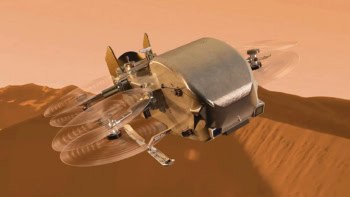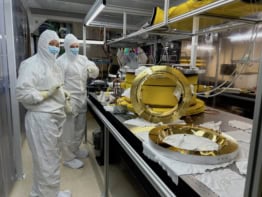Strong evidence for the existence of water ice on the surface of Mars has been found by the Odyssey mission. The discovery could help to answer one of the oldest questions about our neighbouring planet: what happened to the huge quantity of water that many astronomers suspect created the dramatic surface features seen on Mars? An international collaboration of astronomers found the tell-tale signature of hydrogen – likely to be in the form of frozen water – in data gathered by the gamma-ray spectrometer on board the Odyssey spacecraft.
The early results from Odyssey are based on studies of gamma rays and neutrons ejected from the surface of Mars by reactions with cosmic rays. Mars has no magnetic field and only a thin atmosphere, so cosmic rays – particularly protons and alpha particles – can penetrate a metre or so into its soil. When nuclei in this soil absorb these energetic particles, they are excited into higher energy states, and release gamma rays when they return to their ground states. The atoms can also be transformed into different elements by absorbing protons and emitting neutrons of various energies.
Since each element emits a characteristic spectrum of gamma rays – or neutrons with a certain energy distribution – these can reveal the composition of the surface of the planet. The gamma-ray spectrometer consists of three instruments that analyse these emissions: the gamma subsystem, the neutron spectrometer and the high-energy neutron detector. The findings from each instrument are published in separate papers in today’s issue of Science (W Boynton et al; W Feldman et al; I Mitrofanov et al; 2002 Science to appear).
The gamma subsystem found that the regions near the poles of Mars are rich in hydrogen. It also suggests that the surface of Mars consists of a layer of hydrogen-rich material several tens of centimetres thick, covered by a thinner layer of hydrogen-poor material. The hydrogen signal also became weaker below latitudes of about 60°, which suggests that it was attenuated by an increasing thickness of the hydrogen-poor layer towards the equator. The thick layer is thought to contain about 35% water ice, compared with just a few percent in the upper layer.
The high-energy neutron detector and the neutron spectrometer classify neutrons into three bands of ascending energy: thermal, epithermal and fast. When cosmic rays hit hydrogen nuclei, the neutrons emitted have energies in the epithermal energy range, between 0.4 eV and 500 keV. The instruments found that the flux of these neutrons at latitudes above 60° was high, but that the flux of thermal neutrons was higher towards the equator.
The researchers believe that this result is consistent with the conclusions from the gamma-ray study because the energy of epithermal neutrons emitted by hydrogen nuclei in the lower layer would be reduced as these neutrons travelled through the upper layer. The pattern of flux intensity also appeared to match the maps of gamma ray intensity.
The researchers admit that the hydrogen they have detected could be contained in hydroxide-based minerals, but say that the combination of ice-rich and ice-poor layers fits the data well. Since the instruments have only probed the top metre or so of the soil, they even speculate that the surface layers could be just the tip of a larger reservoir of ice beneath the surface of the red planet.
Odyssey was launched in April 2001 and reached Mars last October. Its mission is planned to last until August 2004.



